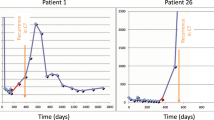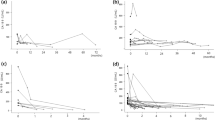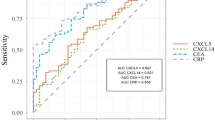Abstract
Serum concentrations of the CA 19-9 antigen were determined in 91 patients with pancreatic cancer and in 111 patients with benign pancreatic, biliary and hepatocellular diseases. The CA 19-9 concentration was above the cut-off limit (37 U ml-1) in 78% of the patients with pancreatic cancer and high levels (greater than 500 U ml-1) were seen in 56% of these patients. Elevated levels were also seen in benign diseases (22%), especially in patients with extrahepatic cholestasis (up to 440 U ml-1). Hepatocellular jaundice and pancreatitis were associated with normal values (84% of the patients), or with only slightly elevated CA 19-9 levels (up to 88 U ml-1). The CA 19-9 test can be useful as an additional diagnostic tool for the detection of pancreatic cancer. Preliminary results suggest that the CA 19-9 assay can be used in the monitoring of surgically treated patients.
This is a preview of subscription content, access via your institution
Access options
Subscribe to this journal
Receive 24 print issues and online access
$259.00 per year
only $10.79 per issue
Buy this article
- Purchase on Springer Link
- Instant access to full article PDF
Prices may be subject to local taxes which are calculated during checkout
Similar content being viewed by others
Rights and permissions
About this article
Cite this article
Haglund, C., Roberts, P., Kuusela, P. et al. Evaluation of CA 19-9 as a serum tumour marker in pancreatic cancer. Br J Cancer 53, 197–202 (1986). https://doi.org/10.1038/bjc.1986.35
Issue Date:
DOI: https://doi.org/10.1038/bjc.1986.35
This article is cited by
-
A case of raised CA 19–9 in a patient with desmoplastic fibroblastoma of the upper limb
International Cancer Conference Journal (2021)
-
Elevated serum CA19-9 level is a promising predictor for poor prognosis in patients with resectable pancreatic ductal adenocarcinoma: a pilot study
World Journal of Surgical Oncology (2014)
-
AB0 blood group and prognosis in patients with pancreatic cancer
BMC Cancer (2012)
-
CA 19-9 as a biomarker in advanced pancreatic cancer patients randomised to gemcitabine plus axitinib or gemcitabine alone
British Journal of Cancer (2009)
-
CA 19-9 and Survival in Advanced and Unresectable Pancreatic Adenocarcinoma and Cholangiocarcinoma
Journal of Gastrointestinal Cancer (2007)



